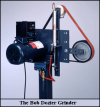- Joined
- Jun 8, 2006
- Messages
- 254
Best I can tell wheel is square, but when I hit it with a blade it crawls from right to left. Be fore I start replacing the wheel or more I thought I would ask. Already tried different belts and such. Maybe too much or too little belt tension? Thanks for input.

